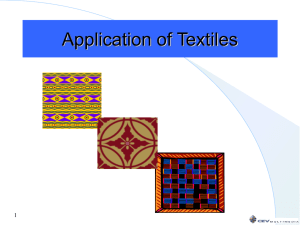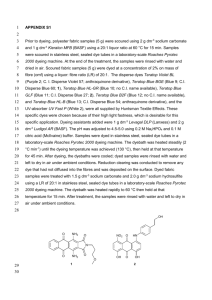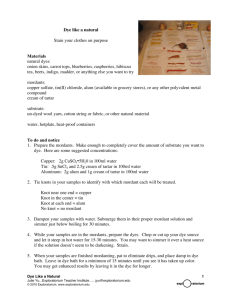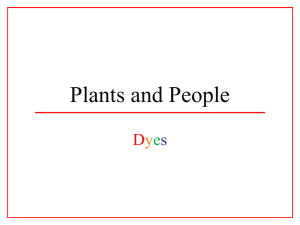are usually used for scouring ... The efficiency of both combined ... finishing production. These chemicals
advertisement
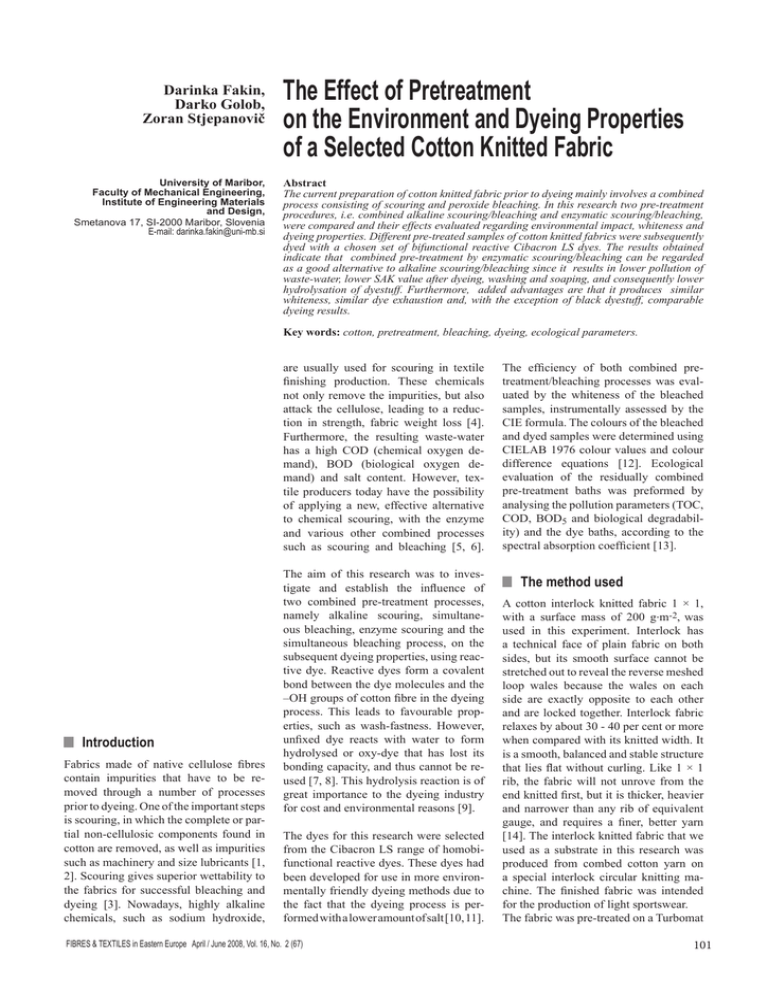
Darinka Fakin, Darko Golob, Zoran Stjepanovič University of Maribor, Faculty of Mechanical Engineering, Institute of Engineering Materials and Design, Smetanova 17, SI-2000 Maribor, Slovenia E-mail: darinka.fakin@uni-mb.si The Effect of Pretreatment on the Environment and Dyeing Properties of a Selected Cotton Knitted Fabric Abstract The current preparation of cotton knitted fabric prior to dyeing mainly involves a combined process consisting of scouring and peroxide bleaching. In this research two pre-treatment procedures, i.e. combined alkaline scouring/bleaching and enzymatic scouring/bleaching, were compared and their effects evaluated regarding environmental impact, whiteness and dyeing properties. Different pre-treated samples of cotton knitted fabrics were subsequently dyed with a chosen set of bifunctional reactive Cibacron LS dyes. The results obtained indicate that combined pre-treatment by enzymatic scouring/bleaching can be regarded as a good alternative to alkaline scouring/bleaching since it results in lower pollution of waste-water, lower SAK value after dyeing, washing and soaping, and consequently lower hydrolysation of dyestuff. Furthermore, added advantages are that it produces similar whiteness, similar dye exhaustion and, with the exception of black dyestuff, comparable dyeing results. Key words: cotton, pretreatment, bleaching, dyeing, ecological parameters. are usually used for scouring in textile finishing production. These chemicals not only remove the impurities, but also attack the cellulose, leading to a reduction in strength, fabric weight loss [4]. Furthermore, the resulting waste-water has a high COD (chemical oxygen demand), BOD (biological oxygen demand) and salt content. However, textile producers today have the possibility of applying a new, effective alternative to chemical scouring, with the enzyme and various other combined processes such as scouring and bleaching [5, 6]. nIntroduction Fabrics made of native cellulose fibres contain impurities that have to be removed through a number of processes prior to dyeing. One of the important steps is scouring, in which the complete or partial non-cellulosic components found in cotton are removed, as well as impurities such as machinery and size lubricants [1, 2]. Scouring gives superior wettability to the fabrics for successful bleaching and dyeing [3]. Nowadays, highly alkaline chemicals, such as sodium hydroxide, The aim of this research was to investigate and establish the influence of two combined pre-treatment processes, namely alkaline scouring, simultaneous bleaching, enzyme scouring and the simultaneous bleaching process, on the subsequent dyeing properties, using reactive dye. Reactive dyes form a covalent bond between the dye molecules and the –OH groups of cotton fibre in the dyeing process. This leads to favourable properties, such as wash-fastness. However, unfixed dye reacts with water to form hydrolysed or oxy-dye that has lost its bonding capacity, and thus cannot be reused [7, 8]. This hydrolysis reaction is of great importance to the dyeing industry for cost and environmental reasons [9]. The dyes for this research were selected from the Cibacron LS range of homobifunctional reactive dyes. These dyes had been developed for use in more environmentally friendly dyeing methods due to the fact that the dyeing process is performed with a lower amount of salt [10, 11]. FIBRES & TEXTILES in Eastern Europe April / June 2008, Vol. 16, No. 2 (67) The efficiency of both combined pretreatment/bleaching processes was evaluated by the whiteness of the bleached samples, instrumentally assessed by the CIE formula. The colours of the bleached and dyed samples were determined using CIELAB 1976 colour values and colour difference equations [12]. Ecological evaluation of the residually combined pre-treatment baths was preformed by analysing the pollution parameters (TOC, COD, BOD5 and biological degradability) and the dye baths, according to the spectral absorption coefficient [13]. nThe method used A cotton interlock knitted fabric 1 × 1, with a surface mass of 200 g.m-2, was used in this experiment. Interlock has a technical face of plain fabric on both sides, but its smooth surface cannot be stretched out to reveal the reverse meshed loop wales because the wales on each side are exactly opposite to each other and are locked together. Interlock fabric relaxes by about 30 - 40 per cent or more when compared with its knitted width. It is a smooth, balanced and stable structure that lies flat without curling. Like 1 × 1 rib, the fabric will not unrove from the end knitted first, but it is thicker, heavier and narrower than any rib of equivalent gauge, and requires a finer, better yarn [14]. The interlock knitted fabric that we used as a substrate in this research was produced from combed cotton yarn on a special interlock circular knitting machine. The finished fabric was intended for the production of light sportswear. The fabric was pre-treated on a Turbomat 101 laboratory apparatus at a liquor ratio of 8:1 using two different procedures for simultaneous scouring and bleaching: modified alkali pre-treatment and enzymatic pre-treatment. The modified alkali pre-treatment and bleaching started at 50 ºC in the presence of a 0.4% wetting agent (Sandoclean JSF). The bath was circulated for 5 mins, after which 6% sodium hydroxide (w(NaOH) = 35%) and a pH stabiliser (Sirrix SB) were added. After a further 5 mins circulation, 4% hydrogen peroxide (w(H2O2) = 35%) was added, then the bath temperature was raised to 115 ºC at a gradient 3 ºC/min and maintained for 15 mins. The enzymatic pre-treatment and bleaching started at 30ºC with an addition of 1 ml/l of a commercial synergistic mixture of enzymes containing pectinases, hemicellulases and cellulases (Baylase EVO), and 1 ml/l of a bleaching stabiliser (Tanex GEO). The bath was then heated to 98 ºC at a gradient 3 ºC/min. At 75 ºC 1 ml/l of the bleaching stabiliser (Tanex GEO), 1 ml/l of a wetting and an emulsifying agent (Plexene PREB), 2% (owf) sodium hydroxide (w(NaOH) = 35%) and 5% hydrogen peroxide (w(H2O2) = 35%) were added. At 98 ºC the bleaching process continued for 30 mins. Both pre-treatment procedures were completed with neutralisation and rinse. 30 mins. Afterwards the dyebath was cooled to 70 °C over 10 mins, and the fixation of the dyestuffs was performed with the addition of 5 g/l of sodium carbonate (Na2CO3) and 1 g/l of sodium hydroxide (w(NaOH) = 35%). Rinsing with water followed, as well as neutralisation and soaping with 1 g/l of a soaping agent (Tanaterge RE). The whiteness of each pretreated and chemically bleached sample was evaluated on the basis of the following CIE equation for illuminant D65 and 1964 10° observer: Ecological studies of the residual baths were performed by analysing the Biochemical Oxygen Demand (BOD5), according to SIST EN 1899-2, the Chemical Oxygen Demand (COD) according to SIST ISO 6060, the Total Organic Carbon (TOC) according to SIST ISO 8245, the biological degradation as a ratio of BOD5 and COD, and the spectral absorption coefficient SAC according to SIST EN ISO 7887. W = Y + 800(xn – x) + 1700 (yn – y) (1) where Y is the tristimulus value of the sample; x and y are the chromaticity coordinates of the sample, xn and yn are the chromaticity coordinates for the perfect reflecting diffuser (0.3138 and 0.3310, respectively). The pre-treated and bleached samples were subsequently dyed with Cibacron LS (Black LS-N HC, Navy LS-G HC, Red LS-B HC) reactive dyes on the Turbomat laboratory apparatus at a liquor ratio of 15:1. The initial dyeing temperature was 30 °C and the dyebath consisted of 0.5% peroxide destroyer (Bactasol ARL), 1% of a dispersant agent (Topex ZB) and electrolyte (30 g/l NaCl). Within 20 mins the dyebath was heated to 80 °C, after which the dye was added (2% o.w.f.). Then the dyebath was further heated to 90 °C and dyeing was performed for 102 The concentration of dye in the dyebath was determined by absorbance measurements performed every ten minutes throughout the dyeing process using a Varian Cary 50 spectrophotometer. A measurement probe with an optical length of 2 mm was used to follow the absorbance of the dye in the dyebath at the absorption maximum of the Cibacron Black LS-N HC dye at 608 nm, the Cibacron Navy LS-G HC dye at 623 nm and the Cibacron Red LS-B HC dye at 514 nm. The dye concentration in the dye-bath and on the fibres, respectively, was calculated according to the Lambert-Beer law: A = k.c.l (2) where A is the measured absorbance, k is the absorption coefficient of the dye in lg-1cm-1, c is the concentration of the dye in g/l and l is the length of the optical path in cm. The pretreated and dyed samples of the cotton knitted fabric were colorimetrically evaluated using a SF 600+ spectrophotometer (Datacolor). The CIE equation was used to calculate the whiteness of the scoured and bleached samples, the CIELAB colour values (lightness L*, red/green axis a*, yellow/blue axis b*, chroma C*, and hue h), and the CIELAB colour differences (ΔE*) were determined for the dyed samples. nResults and discussion The results of the ecological analysis of the residual pre-treatment baths are presented in Figure 1 and the colorimetrical evaluations of the pre-treated samples are in Figure 2. The samples are denoted in the tables and figures by: ASB - alkaline scouring and bleaching, and ESB - enzymatic scouring and bleaching. Ecological impacts The ecological analyses of the residual baths clearly showed the difference between the combined pre-treatment and bleaching processes performed. The TOC value of the residual bath after modified alkali pre-treatment was 20% higher than the TOC of the enzymatic pre-treatment waste-water. Since the TOC value gives the amount of total organic compounds present in wastewater, the lowest value of this parameter for the enzymatic pre-treatment is additional proof of its environmentally-friendly character. The COD and BOD5 values give the amount of oxygen needed for the oxidative and biological degradations of organic compounds in wastewater, respectively. The COD for the modified alkali pre-treatment wastewater was 41% and for BOD5 31% higher than that for the enzymatic pre-treatment wastewater. Both wastewaters of the pre-treatment were totally biologically degradable (for modified alkali pre-treatment it was 3.37, for enzymatic pre-treatment 3.43). The residual baths analysed were concentrated because the rinsing baths, which certainly lowered these values on an industrial scale, were not included; therefore, the relative comparison between the procedures is even more realistic. It should be noted that both pre-treatment processes have a strong impact on envi- Figure 1. A comparison of the ecological parameters of the wastewater after applying combined pre-treatment and bleaching processes. Table 1. Whiteness (CIE W) and lightness (L*) of raw fabric and different pre-treated and bleached samples. Samples CIE W L* Raw 0 85.1 ASB 66.9 93.5 ESB 61.6 93.4 FIBRES & TEXTILES in Eastern Europe April / June 2008, Vol. 16, No. 2 (67) a) b) c) Figure 2. Exhaustion during the dyeing with 1%: a) Cibacron Black LS – N HC, b) Cibacron Navy LS – G HC, c) Cibacron Red LS – B HC on different pre-treated and bleached knitted fabrics. ronmental pollution, since all the ecological parameters exceeded the limits stated in Slovenian regulations (TOC = 60 g/l, COD = 200 g/l and BOD5 = 30 g/l) [15]. However, after combined single-bath scouring and bleaching, the volume of wastewater is significantly reduced. All the ecological parameters analysed indicated that the degree of pollution of the residual baths was insignificant after enzymatic pre treatment and bleaching. Colorimetrical evaluation Table 1 presents the results of whiteness measurement, and the lightness obtained on raw fabric for both the combined pretreated and bleached samples. The results show that the lightness L* is high for pre-treated samples and indicates no significant difference. However, the CIE whiteness obtained using the alkali pre-treatment procedure (66.9) was higher compared to that using the enzymatic procedure (61.6), mainly caused by differences the b* axes. Afterwards, the modified alkali pretreatment and enzymatic treated cotton knitted fabrics were dyed using the three selected homobifunctional reactive Cibacron LS dyes. Figure 2 show the exhaustion of the dyes from the bath, or/and the measured absorbance during the dyeing process, respectively. The exhaustion curves define the time needed for reaching equilibrium, which depends on the time and temperature distribution of the dyes between the dye bath and different pre-treated cotton fibres during the dyeing process. Homobireactive dyes form a covalent bond with cotton fibres in the dyeing process, but the problem is that a reactive group of dyes can not only react with a –OH group of cellulose, but also with a –OH group of water. This reaction forms hydrolysed dyes; however, they cannot react with fibres and remain in the bath and on the surface on the fibres. The quantity of hydrolysed dyes is dependent on the chemical structure of dyestuffs and dyeing properties. Figure 2 (a, b, and c) present three different dyestuffs used at the same conditions. It can be seen that with Cibacron Black LS – N HC we reached 84 % dyeing exhaustion, with Cibacron Navy LS – G HC 94/95 %, with Cibacron Red LS – B HC it was only 81% using alkali pre-treated and 78.5% using enzymatic pre-treated cotton knitted fabric. Tables 2 and 3 show the colour intensity of the dyeing wastewater. Residual dyestuffs in dye-bath effluents cause maximum absorption at different wavelengths of the incident radiation. According to the standard method (SIST EN ISO 787:1994), the colour of the water is determined by spectrophotometrical measurement at three different wavelengths, distributed over the range of the visible spectrum; λ1 = 436 nm, λ2 = 525 nm and λ3 = 620 nm [15]. According to Slovenian decree, limited coloration of the effluents fed into natural water streams should not exceed the SAC values of 7, 5 and 3 at the wavelengths of 436 nm, 525 nm and 620 nm, respectively. It is evident from the results that SAC values of 436 nm, in all cases, were below the limits stipulated, but only black, at 525 nm, red at 620 nm, black and navy blue dyes slightly exceeded the limits. The combined enzymatic pretreatment and bleaching process caused lower spectral absorption values for dyeing, washing and soaping wastewater in comparison to combined alkaline scouring and bleaching. This means that alkaline scouring and bleaching caused a higher quantity of hydrolysed dyestuffs in dye-bath. The dyed samples in all concentrations were colorimetrically evaluated using the CIELAB colour system. CIELAB colour values for 2 % added dyestuffs are shown in Table 4. Table 2. Spectral absorption coefficient values (SAC) for (ASB) residual dyeing wastewater; Dye: dyeing; Was: washing; Soa: soaping. Dyestuff Cibacron Dyestuff conc., % SAC (nm) 436 Dye./ Wash./ Soa. 525 Dye./ Wash./ Soa. 620 Dye./ Wash./ Soa. Black LS-N HC 1.0 2.0 2.71 / 0.24 / 0.03 6.23 / 0.62 / 0.09 3.07 / 0.23 / 0.02 6.93 / 0.60 / 0.07 2.74 / 0.18 / 0.01 6.05 / 0.51 / 0.05 Navy LS-G HC 1.0 2.0 1.16 / 0.17 / 0.02 1.89 / 0.25 / 0.04 1.94 / 0.22 / 0.02 4.02 / 0.39 / 0.05 2.06 / 0.31 / 0.03 5.86 / 0.62 / 0.12 Red LS-B HC 1.0 2.0 0.57 / 0.12 / 0.04 1.73 / 0.28 / 0.02 2.43 / 0.35 / 0.06 6.66 / 0.85 / 0.05 0.04 / 0.03 / 0.00 0.05/ 0.07 / 0.00 Table 3. Spectral absorption coefficient values (SAC) for (ESB) residual dyeing wastewater; Dye: dyeing; Was: washing; Soa: soaping. Dyestuff Cibacron Dyestuff conc. (%) Black LS-N HC SAC (nm) 436 Dye./ Wash./ Soa. 525 Dye./ Wash./ Soa. 620 Dye./ Wash./ Soa. 1.0 2.0 2.51 / 0.31 / 0.07 6.21 / 0.59 / 0.10 2.33 / 0.24 / 0.01 6.33 / 0.52 / 0.03 2.05 / 0.23 / 0.01 5.84 / 0.43 / 0.05 Navy LS-G HC 1.0 2.0 0.63 / 0.16 / 0.06 1.91 / 0.21 / 0.15 1.39 / 0.15 / 0.01 3.26 / 0.24 / 0.10 1.69 / 0.35 / 0.01 4.82 / 0.39 / 0.25 Red LS-B HC 1.0 2.0 0.64 / 0.09 / 0.03 1.66 / 0.13 / 0.03 1.88 / 0.27 / 0.03 6.22 / 0.43 / 0.04 0.02 / 0.00 / 0.00 0.10 / 0.00 / 0.00 FIBRES & TEXTILES in Eastern Europe April / June 2008, Vol. 16, No. 2 (67) 103 Table 4. CIELAB colour values of differently pre-treated samples dyed with Cibacron LS dyestuffs (2% o.w.f.). Samples ASB and dyeing ESB and dyeing Dyestuffs L* a* b* C* H Black LS-N HC 21.6 -1.9 -3.3 3.8 240.4 Navy LS-G HC 23.9 -6.3 -16.1 17.3 248.6 Red LS-B HC 38.7 57.5 -0.4 57.5 359.6 Black LS-N HC 25.7 -2.9 -4.2 5.1 234.9 Navy LS-G HC 24.0 -6.5 -16.1 17.3 248.0 Red LS-B HC 38.7 57.8 -0.8 57.8 359.2 Figure 5. Colour differences of differently pre-treated and dyed cotton fabrics. CIELAB colour values of the dyed samples confirmed that the pre-treatment process had no important influence on the dyeing properties of the samples dyed using Cibacron Navy LS-G HC and Red LS-B HC dyes, since both pre-treated and dyed samples have practically the same colour. The pre-treatment process affected dyeing when using Cibacron Black LS-N HC dye because the samples prepared with the combined alkali procedure, and subsequently dyed using the same dye, were darker and less saturated. The colour differences are shown in Figure 3. Only the samples dyed using Cibacron Black LS-N HC had noticeable colour differences (ΔE*= 4.3), especially a lightness difference (ΔL*= 4.1). Other samples had colour differences below 0.5, which could not be noticed by the naked eye. nConclusions The results obtained indicate that the combined single-bath pre-treatment processes performed, comprising scouring and bleaching, have a significant influence on the ecological parameters of the residual baths, but a minor influence on the whiteness and colour of the dyed cotton interlock knitted fabric, using Cibacron LS reactive dyes. Ecological analyses of the residual baths clearly showed the difference in the environmental impacts of both the chemical pre-treatment processes performed. The 104 ecological parameters analysed confirmed that the degree of pollution of the residual baths was considerably higher (COD by 41%, BOD5 by 31% and TOC by 20%) for combined alkali scouring/bleaching than for the enzymatic scouring/bleaching process. The problem connected with dyeing using reactive dyestuffs is their hydrolysation in the dye-bath. The results obtained by measuring the SAC value indicated that the combined enzymatic scouring/bleaching process produced a lower SAC value and, therefore, a lower quantity of hydrolysing dyestuff in the dye-bath and in the fibres. The colour values of differently pretreated and equally dyed cotton interlock knitted fabric using three selected Cibacron LS reactive dyes were very similar for Navy LS-G HC and Red LS-B HC dyes, whereas a greater difference (ΔE*= 4.3) was obtained with Cibacron Black LS-N HC dyestuff, where combined alkali scouring/bleaching pre-treatment produced a darker and less chromatic black colour. Combined pre-treatment with enzymes and bleaching is a good alternative to conventional or modified alkaline scouring because it results in lower pollution rates, similar whiteness and comparable dyeing results. References 1. G. V. Madaras, G.J. Parish, J. Shore: Bathwise dyeing of woven cellulosic Fabrics, Society of dyers and colourists, ISBN 0 901956 55 4, Manchester, 1993. 2. S. H. Bae, H. Motomura, Z. Morita: Diffusion/Adsorption Behaviour of reactive Dyes in Cellulose. Dyes and Pigments, 34, 321-339, 1997. 3. S. McCaffery, G.K. Santokhi: The preparation of cotton knitgoods. Society of Dyers and Colorists, 115(may/june), 167-172, 1999. 4. H. A. Krassig: Cellulose, Structure, Accessibility and Reactivity, Switzerland: Gordon and Breach Science Publishers, 1992. 5. L. Burget, J. Prikryl, J. Ruzicka, J. Akrman: The Ecological Aspect of cellulose Fibre Bleaching. Fibres and Textiles in Eastern Europe, January/February, 34-36, 1994. 6. G. Buschle-Diller, X.D. Yang: Enzymatic Bleaching of cotton Fabric with Glucose Oxidase. Textile Research Journal, 71(5), 388-394, 2001. 7. S. Karcher, A. Kornmuller, M. Jekel: Anion exchange resins for removal of reactive dyes from textile wastewaters. Water Research, 36, 4717-4724, 2002. 8. S. Timofei, W. Schmidt, L. Kurunczi, Z. Simon: A review of QRAR for dye affinity for cellulose fibres. Dyes and Pigments, 47, 5-16, 2000. 9. A. Zotou, I. Eleftheriadis, M. Heli, S. Pegiadou: Ion-pair high performance liquid chromatographic study of the hydrolysis behaviour of reactive fluorotriazinic dyes. Dyes and Pigments, 53(3), 267-275, 2002. 10. P. Galafassi, A. Tzikas: Cibacron LS Dyes, Ciba Specialty, Basel, 2005. 11. K. Imada: Dyeing technologies and their applications, Avaiable from: http:// textileinfo.com/en/tech/imada/hannnou/ page02.html, 15.4.2005. 12. V. Golob: Colorimetry. University of Maribor; Faculty of Mechanical engineering, 2001. 13. J. Đonlagić: Significance and Way of Determining Relevant Nonspecific Parameters for Textile Wastewater Evaluation. Tekstilec, 11-12, 343-350, 2001. 14. J.D. Spencer: Knitting Technology, Third Edition. Woodhead Publishing Ltd., Cambridge, 2001. 15. Official Gazette of the Republic of Slovenia. Decree regarding substance emission during the removal of wastewater from systems and installations during the production, reproduction and handling of textile fibres 35, 2969-2972, 1996. Received 14.06.2007 Reviewed 23.01.2008 FIBRES & TEXTILES in Eastern Europe April / June 2008, Vol. 16, No. 2 (67)

